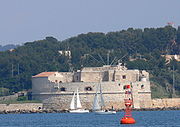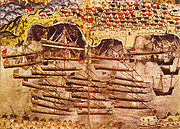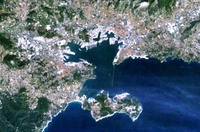
Tour Royale, Toulon
Encyclopedia

Toulon
Toulon is a town in southern France and a large military harbor on the Mediterranean coast, with a major French naval base. Located in the Provence-Alpes-Côte-d'Azur region, Toulon is the capital of the Var department in the former province of Provence....
. It was the first fortification of the harbor, built 22 years after Provence
Provence
Provence ; Provençal: Provença in classical norm or Prouvènço in Mistralian norm) is a region of south eastern France on the Mediterranean adjacent to Italy. It is part of the administrative région of Provence-Alpes-Côte d'Azur...
became a part of France.
The fort was commissioned in 1513 by King Louis XII at the request of the bishop of Toulon and of the Senechal of Provence. It was placed on the cap de la Manegue, at the end of the pointe de la Mitre, where it could fire at any ships coming into the Rade. The design was by the Italian engineer Gian-Antonio della Porta.. It was a classical example of a Torrioni, a round tower with cannon, constructed around Renaissance Italy in the 16th century. The tower was sixty meters in diameter and seven meters thick. Construction began in 1514 and was finished in 1524, during the reign of Francis I of France
Francis I of France
Francis I was King of France from 1515 until his death. During his reign, huge cultural changes took place in France and he has been called France's original Renaissance monarch...
, at a cost of 30,000 florins. Because of its impressive size, the residents of Toulon called "La Grosse Tour."
The tower had hardly been finished when it was captured by the army of Charles V, Holy Roman Emperor
Charles V, Holy Roman Emperor
Charles V was ruler of the Holy Roman Empire from 1519 and, as Charles I, of the Spanish Empire from 1516 until his voluntary retirement and abdication in favor of his younger brother Ferdinand I and his son Philip II in 1556.As...
, led by the Connetable de Bourbon, when he invaded Provence. The Connetable avoided a long and costly siege by simply paying the commander of the fort 500 ecues to surrender. After the commander and garrison took their money and left, the fort was occupied by 300 Spanish mercenaries. This event led a the coining of an expression in Toulon, "to be sold like the Grosse Tour."
When the Imperial army left, the fort was used to imprison the chevalier Bertrande de la Garde, who had fought for Charles V against Francis I. He was the first of many political prisoners to be held in the underground cells of the fort.

Franco-Ottoman alliance
The Franco-Ottoman alliance, also Franco-Turkish alliance, was an alliance established in 1536 between the king of France Francis I and the Turkish ruler of the Ottoman Empire Suleiman the Magnificent. The alliance has been called "the first non-ideological diplomatic alliance of its kind between a...
with the Ottoman Sultan Suleiman the Magnificent
Suleiman the Magnificent
Suleiman I was the tenth and longest-reigning Sultan of the Ottoman Empire, from 1520 to his death in 1566. He is known in the West as Suleiman the Magnificent and in the East, as "The Lawgiver" , for his complete reconstruction of the Ottoman legal system...
, and invited the Ottoman fleet to spend the winter in Toulon harbour. The Tour Royale was used to store all the artillery from the ramparts of Toulon, until the Ottoman fleet departed.
In 1572, when the news of the massacre of Protestants in Paris on St. Bartholomew's Day became known, the commander of the fort, Nicolas de Pignan, gave sanctuary to the Protestant families of Toulon within the fort.
In 1596, during the wars of religion across France, the commander of the Chateau D'If
Château d'If
The Château d'If is a fortress located on the island of If, the smallest island in the Frioul Archipelago situated in the Mediterranean Sea about a mile offshore in the Bay of Marseille in southeastern France...
, who had remained loyal to Henry IV of France
Henry IV of France
Henry IV , Henri-Quatre, was King of France from 1589 to 1610 and King of Navarre from 1572 to 1610. He was the first monarch of the Bourbon branch of the Capetian dynasty in France....
, had a meeting in the Tour Royale with the Duke de Guise, Governor of Provence, to agree on a way to drive the Spaniards from Marseille
Marseille
Marseille , known in antiquity as Massalia , is the second largest city in France, after Paris, with a population of 852,395 within its administrative limits on a land area of . The urban area of Marseille extends beyond the city limits with a population of over 1,420,000 on an area of...
, which had declared itself an independent republic.'
In 1634, Cardinal Richelieu decided to strengthen the harbor defenses and had a second fort, Fort Ballaguier, constructed opposite the Tour Royale.
In 1679, Louis XIV sent his chief military architect, Vauban
Vauban
Sébastien Le Prestre, Seigneur de Vauban and later Marquis de Vauban , commonly referred to as Vauban, was a Marshal of France and the foremost military engineer of his age, famed for his skill in both designing fortifications and breaking through them...
, to make the fortifications of Toulon strong enough to resist a British attack. Vauban described the Tour Royale as a "very beautiful work with several floors and batteries," but he considered it unfinished.. He recommended adding another level of cannons, and a new battery at the foot of the tower, and lowering the hills around to give the gunners a clearer view of approaching enemy ships.
The Tour was equipped with forty cannon, but Vauban's other improvements were not carried out. Nonetheless, in 1707, during the War of the Spanish Succession
War of the Spanish Succession
The War of the Spanish Succession was fought among several European powers, including a divided Spain, over the possible unification of the Kingdoms of Spain and France under one Bourbon monarch. As France and Spain were among the most powerful states of Europe, such a unification would have...
, the Tour helped Toulon to successfully resist a combined attack and siege by a British-Dutch fleet and the army of Eugene of Savoy.
In 1770, a new fort, Fort Lamalgue, was constructed at the harbor entrance, the Tour Royale was no longer as important for the defense of the port. It became primarily a place to lock up military prisoners, Coriscan rebels, and, during the French Revolution
French Revolution
The French Revolution , sometimes distinguished as the 'Great French Revolution' , was a period of radical social and political upheaval in France and Europe. The absolute monarchy that had ruled France for centuries collapsed in three years...
, first royalists and then supporters of the Republic.
In 1798, when Napoleon Bonaparte's fleet of 200 ships departed Toulon for Egypt, the future Empress Josephine watched the departure of the fleet from the Tour Royale.

The Tour Royale was classified as an historic monument on April 11, 1947. the underground cells were filled in, and the chapel, barracks and hospital were removed, but the casemates, circular galleries and embrasures for the cannon still remain as they were.
In 2004, the tower became a museum, and in 2006, it was transferred from the Ministry of Defense to the city of Toulon. and opened to the public. A coastal path from the fort connects it to the beaches of Mourillon.
As of September 2010 the Tour Royale is open to the public from July 1 until October 31, on Wednesdays, Saturdays and Sundays, from 900 until 1200 and from 1400 until 1800.

